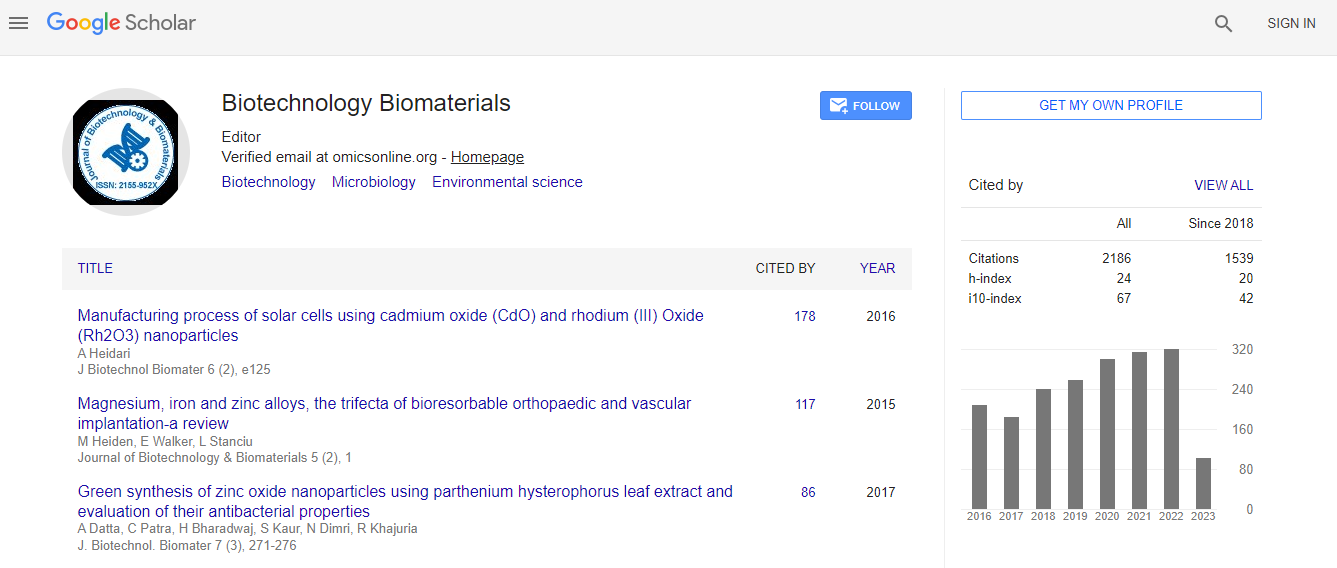Our Group organises 3000+ Global Conferenceseries Events every year across USA, Europe & Asia with support from 1000 more scientific Societies and Publishes 700+ Open Access Journals which contains over 50000 eminent personalities, reputed scientists as editorial board members.
Open Access Journals gaining more Readers and Citations
700 Journals and 15,000,000 Readers Each Journal is getting 25,000+ Readers
Google Scholar citation report
Citations : 3330
Journal of Biotechnology & Biomaterials received 3330 citations as per Google Scholar report
Indexed In
- Index Copernicus
- Google Scholar
- Sherpa Romeo
- Open J Gate
- Genamics JournalSeek
- Academic Keys
- ResearchBible
- China National Knowledge Infrastructure (CNKI)
- Access to Global Online Research in Agriculture (AGORA)
- Electronic Journals Library
- RefSeek
- Hamdard University
- EBSCO A-Z
- OCLC- WorldCat
- SWB online catalog
- Virtual Library of Biology (vifabio)
- Publons
- Geneva Foundation for Medical Education and Research
- Euro Pub
- ICMJE
Useful Links
Recommended Journals
Related Subjects
Share This Page
Estimate infectivity of human Norovirus in environmental water samples by in situ capture RT-qPCR method
2nd World Biotechnology Congress
Peng Tian
Agricultural Research Service, USA
ScientificTracks Abstracts: J Biotechnol Biomater
Abstract
Human Noroviruses (HuNoVs) are highly infectious viruses for which water is an important medium of transmission. In this study, we explored a new in situ capture RT-qPCR (ISC-RT-qPCR) methodology to estimate the infectivity of HuNoV in environmental water samples. This assay was based on capturing encapsidated HuNoV by viral receptors, followed by in situ amplification of the captured viral genomes by RT-qPCR. We demonstrated that the ISC-RT-qPCR did not capture and enable signal amplification of heat-denatured Tulane Virus (TV) and HuNoVs. We further demonstrated that the sensitivity of ISC-RT-qPCR was equal or better than that of conventional RT-qPCR procedures for the detection of HuNoV GI and GII. We then utilized the ISC-RT-qPCR to detect HuNoV in environmental water samples for comparison against that from a conventional RT-qPCR procedure. TV was used as a process control virus. While complete inhibition of TV genomic signal was observed in 27% of samples tested by RT-qPCR, no inhibition of TV genomic signal was observed by ISC-RT-qPCR. From 72 samples tested positive for HuNoV GI signal by RT-qPCR, only 20 (27.8%) of these samples tested positive by ISC-RT-qPCR, suggesting that 72.2% of RT-qPCR-positive samples were unlikely to be infectious. From 16 samples tested positive for HuNoV GII signal by RT-qPCR, only one of these samples tested positive by ISCRT-qPCR. Five samples that had initially tested negative for HuNoV GII signal by RT-qPCR, was tested as positive by ISC-RT-qPCR. Overall, ISC-RT-qPCR method provided an alternative assay to estimate infectivity of HuNoV in environmental samples.Biography
Peng Tian has his expertise in human Norovirus and food safety. He has developed several methods to concentrate and detect human norovirus from environmental and food samples. These approaches are available to all stakeholders interested in viral contamination in food.

 Spanish
Spanish  Chinese
Chinese  Russian
Russian  German
German  French
French  Japanese
Japanese  Portuguese
Portuguese  Hindi
Hindi 
